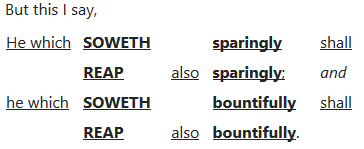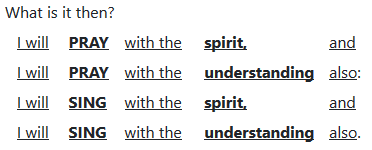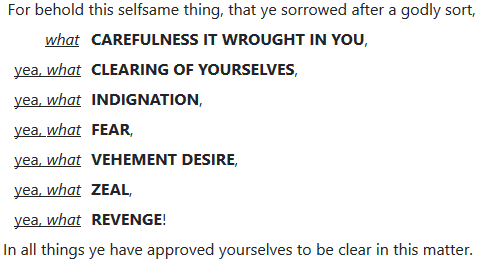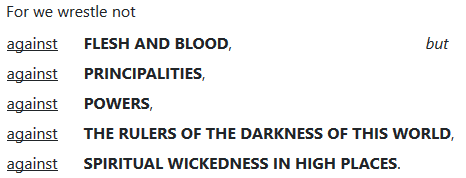Look for Similarities or Differences
Another way to learn scriptures is to identify similarities or differences in key words and phrases.
Procedures for identifying similarities or differences:
- Identify what the verse(s) has in common (similarities)
- Identify key words and phrases not in common (differences).
- Collapse these similarities and differences into an easily remembered phrase or a sentence-like structure.
- Use this phrase or sentence-like structure to expand (unfold) the scripture(s) in your mind as you quote it by “spinning off” the similarities and differences of key words and phrases.
The following scripture illustrates this point:
PHILIPPIANS 4:8
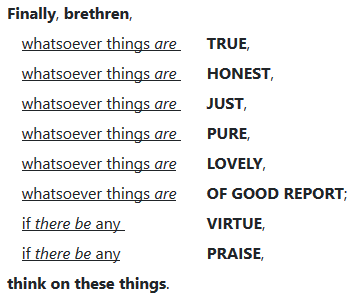
Follow the procedures below to identify similarities or differences for the above scripture:
- Identify common phrases (similarities):
- whatsoever things are
- if there be any
- Identify key words and phrases (differences):
- Finally, brethren
- TRUE
- HONEST
- JUST
- PURE
- LOVELY
- OF GOOD REPORT
- VIRTUE
- PRAISE
- think on these things
- Collapse this passage into an easily remembered sentence-like format:
Finally, brethren, whatsoever things are TRUE, HONEST, JUST, PURE, LOVELY, and OF GOOD REPORT; if there be any VIRTUE or PRAISE, think on these things. - Use this sentence-like format to expand (unfold) the scripture in your mind as you quote it by “spinning off” the similarities and differences of key words or phrases:
- Differences (Key words/phrase): TRUE, HONEST, JUST, PURE, LOVELY, and OF GOOD REPORT
- Differences (Other phrases): Finally brethren and think on these things
- Similarities: whatsoever things are, and if there be any
Animated Demo
TIP: Make a Real Sentence
Instead of a sentence-like format as in the above example, create a real sentence(s) from the key words and phrases themselves to help link them. For instance, instead of trying to remember the above series of key words and phrases without any association, create these sentences:
Finally brethren, whatsoever things are TRUE and HONEST will be JUST PURE and LOVELY and OF a GOOD REPORT. If there be any VIRTUE or PRAISE, think on these things.
You may need to add additional words to make the sentence(s) more memorable. You can then use these sentence(s) to expand on the key words and phrases as you quote the scripture(s).
The following example further highlights this technique:
1 CORINTHIANS 13:11
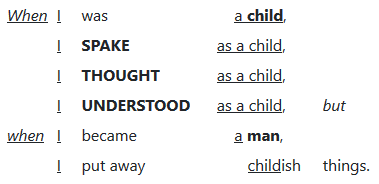
You can make the following sentence-like format:
When I was a child, I SPAKE, THOUGHT, and UNDERSTOOD as a child, but when I became a man, I put away childish things.
While the next passage is a long one, it demonstrates a host of similarities and differences between groups of verses.
1 CORINTHIANS 9:20-22
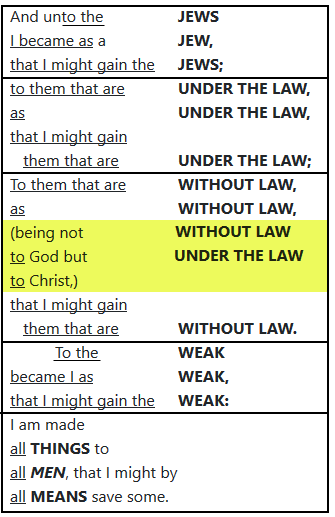
To help you remember most of this long passage, except for the yellow highlighted section in parenthesis, note the following two sentence patterns:
- …to the ________ I became (or became I) as a ________ that I might gain the ________.
- …to them that are ________ as ________ that I might gain them that are ________.
Then, fill in all the blanks with the SAME WORD (JEW(S), UNDER THE LAW, WITHOUT LAW, and WEAK).
The following are some additional verses for your review. See if you can think of sentence-like formats using their key words and phrases. While reading, notice how the primary and secondary key words and phrases capture your attention:

To further help you remember this verse, notice that primary key words are body positions: walk, stand, and sit. You will learn later how you can use the storybook technique to “develop” larger scripture passages from their key words and phrases.

To help learn this verse, you can make the following sentence:
When thou GO to SLEEP and then AWAKE it [the Holy Spirit] shall lead, keep, and talk with thee.

Notice the primary key words (PROPHESIED, CAST OUT DEVILS, and DONE MANY WONDERFUL WORKS) represent great works that a Christian can do.
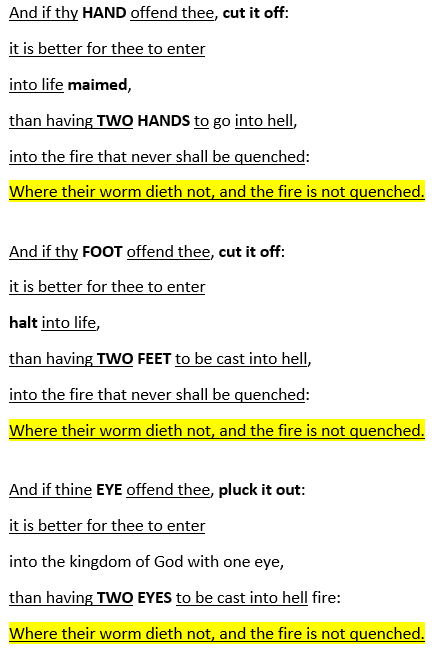
Notice the primary key words (HAND, FOOT, and EYE) represent parts of the body. Also, notice the plurals of these primary key words (TWO HANDS, TWO FEET, and TWO EYES) are highlighted. Moreover, notice each section ends with the phrase, “Where their worm dieth not, and the fire is not quenched.” are highlighted in yellow.

Notice the second set of primary key words represent the Trinity (SPIRIT [THE HOLY SPIRIT], LORD [THE SON], and GOD [THE FATHER]).
To help you remember all of the primary key words, you could think of the following phrases: GIFTS of the SPIRIT, ADMINISTRATIONS of the LORD, and OPERATIONS of GOD.
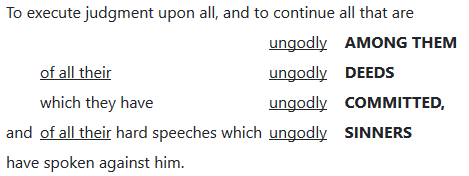
To help you remember the primary key words, think, "Ungodly AMONG THEM include ungodly DEEDS, ungodly COMMITTED by ungodly SINNERS."
